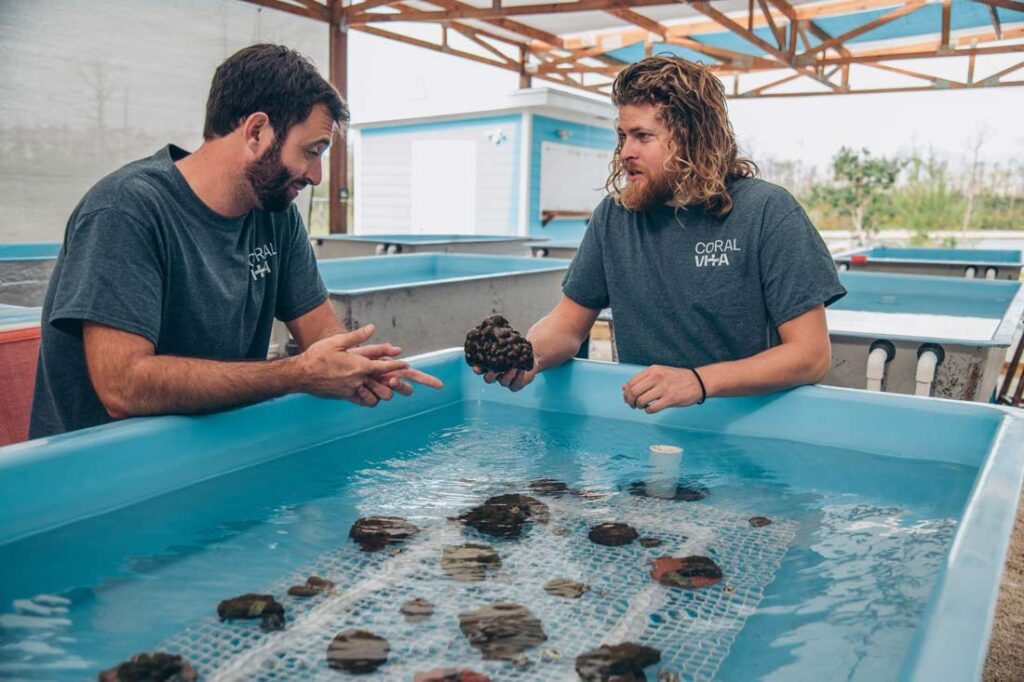I first encountered Coral Vita President and Co-founder Gator Halpern on the Summit at Sea expedition aboard Virgin Voyages. The cruise is an iteration of an annual global meeting hosted by Summit that Jody Levy, the organization’s global director, CEO and owner, says is “a foundation to nurture and connect the makers across the planet, as well as entrepreneurs, investors, people that are really committed to making our world the best it can be.”
There were numerous talks every day of the three-day sail out of Miami, as well as performances, wellness activities, meetups, art showcases and more. Halpern was one of the presenters and hosted a fascinating session with conservation-minded entrepreneurs. He delivered sobering statistics about the state of coral reefs today, explaining that “since the 1970s, half of the world’s reefs have already died. And due to climate change, and other human impacts, it’s projected that over 90% of these ecosystems will be dead by 2050.”
An environmental crisis
Halpern and his Coral Vita Co-founder Sam Teicher are determined to reverse that stat. “This is an existential crisis for the world,” Halpern told the concerned Summit audience. “But I’m not gonna leave you on the bad news, though, because there is something we can do to reverse this. Reef restoration has been shown to bring reefs back to life—you can plant these corals just like you plant trees, and as you see the forest come back to life, you can plant coral and watch this [underwater] ecosystem come back.”
As he described what he and Teicher are doing on Grand Bahama Island, I was intrigued. Being a lifelong scuba diver and lover of all things under the sea, and knowing how the combination of rising ocean temperatures and human carelessness regarding pollution have adversely affected reefs around the planet, I wanted to know more. So once back in Miami, I hopped a quick flight to the city of Freeport on Grand Bahama Island to see just what Halpern, Teicher and their team are accomplishing at their first coral farm (of many planned).
How Coral Vita began
The two men met at the Yale School of Forestry and Environmental Studies. “This was an idea that Gator and I had on the back porch during grad school drinks and beers, in 2014,” Teicher explains with a laugh. We’re chatting in the Coral Vita offices that overlook their land-based water-tank nurseries, where the partners are farming corals at a growing rate that is up to 50 times faster than wild reefs grow. “So we got a $1,000 grant from Yale. And eight years later, we’re sitting here talking to you today, right? With 17 people on staff and tens of thousands of corals being grown!” he continues.
Visiting the coral farm in the Bahamas
The duo launched Coral Vita in 2019, after securing $2 million in investment funds. The company is a for-profit entity that has already attained global recognition, including winning the Earthshot Prize (£1 million) in 2021 and hosting the Prince and Princess of Wales (whose Royal Foundation created the environment-focused prize) at their Bahamas facility in 2022. That royal pair had much the same experience I did, taking the hour-long, $20-per-adult tour of the facility that Coral Vita offers to tourists, school groups and anyone interested in ecology and reef restoration.
The process of restoring coral reefs
Alannah Vellacott, a marine ecologist and coral restoration specialist, guides me through the operation. She’s not only the tour guide (on Mondays and Thursdays, the only days the tours are offered), but also a scientist and one of the many Bahamian locals who work at Coral Vita. She explains how they go about growing the coral, using microfragments of corals from the local reefs, nurturing them to begin to grow, then attaching them to custom-developed circular concrete and ceramic discs known as “cookies.” The team of scientists allows the coral to grow even more in the tanks before finally attaching the discs, now filled with healthy new corals, back onto the reef structure, dead coral or nearby rock.
Seeing this in action meant scuba diving with the Coral Vita team in the shallow waters just off Grand Bahama, where the reefs they are restoring are located (an experience that is not offered to the public). After a very short boat ride into the waters of the Caribbean Sea to Rainbow Reef, their primary existing restoration site, I join Vellacott and her fellow coral restoration specialists Tyriq Forbes and Nick Van Albedyhll, along with Katelyn Gould, Ph.D., Coral Vita’s director of restoration science, to get a close-up look at what they are doing under the water.
An ecosystem worth protecting
This day’s work involves precise undersea measurement to create grids where the scientists will plant the new coral cookies and study them as the coral adapts to its natural environment. Working in extremely shallow water (think 5 to 10 feet), Gould and the team spend hours getting the site ready for the next step. As I watch (and work hard to keep my buoyancy in line at such a shallow depth), a big barracuda lazes past and an enormous lobster creeps a little ways out of his protected rock lair, perhaps looking to score a breakfast treat from the numerous colorful tropical fish nibbling on the coral for their own meals.
It doesn’t hurt that it’s a gorgeous day in paradise, as Gould, a recent transplant from North Carolina, points out. “I got my doctorate in biology, specializing in coral reefs, just so I could spend my days in this environment,” she says with a broad grin. “And I get to help save reefs at the same time. I love my job!”
Scaling Coral Vita
Teicher and Halpern echo her enthusiasm, as they plan for expansion across the globe. “Right now we’re looking at setting up a farm in the [United Arab Emirates], and in other countries, from the Maldives to Jordan, to Barbados to the United States. We’re looking at Florida,” Teicher reveals. “We’re deciding on the place where farm number two is going to be and where our operations could scale to. And we’ve been building our relationships with the private sector, senior stakeholders, government officials, etc. We’re working in Saudi Arabia right now, in fact. Our ultimate vision is that every country on earth that has coral reefs needs large-scale, commercially viable coral farms, because that’s how we really can achieve the level of impact needed to keep the world’s reefs alive and thriving.”
Photo courtesy of Intuitive Communications/Coral Vita




